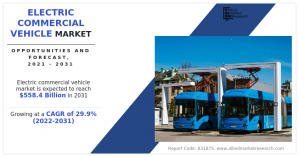Electric Commercial Vehicle (ECV) Market to Skyrocket from USD 43.5B to USD 558.4B by 2031
According to the report, the global electric commercial vehicle industry generated $43.5 billion in 2021, and is anticipated to generate $558.4 billion by 2031, witnessing a CAGR of 29.9% from 2022 to 2031.
Increase in demand for fuel-efficient, high-performance, & low-emission buses, government initiatives for promotion of e-mobility, and reduction in cost of electric vehicle batteries drive the growth of the global electric commercial vehicle market. However, high cost of investment & complication in operating advanced systems and lack of charging infrastructure restrict the market growth. Moreover, increasing demand for electric trucks from the logistics sector, technological advancements, and proactive government initiatives for adoption of e-buses create lucrative growth opportunities for the market.
Request Sample of Research Report - https://www.alliedmarketresearch.com/request-sample/32331
Based on propulsion, the Battery Electric Vehicle (BEV) segment held the highest market share in 2021, accounting for around four-fifths of the global electric commercial vehicle market, and is estimated to maintain its leadership status throughout the forecast period, owing to the adoption of electric buses and trucks in developing as well as developed countries. However, the Fuel Cell Electric Vehicle (FCEV) segment is projected to manifest the highest CAGR of 32.7% from 2022 to 2031, as hydrogen fuel cell vehicles emit water as a by-product and are considered environmentally friendly vehicles.
In addition, manufacturers are introducing new fuel-cell electric commercial vehicles and plan to mass produce these vehicles in the next few years, which are expected to boost the growth of the fuel-cell electric commercial vehicles market. For instance, in July 2022, Hyundai partnered with truck and bus manufacturer Iveco Group to provide a hydrogen fuel cell system for European buses. According to Iveco's bus division, the company plans to produce more than 3,000 of zero and low-emission buses at its Foggia plant in southern Italy from 2023.
Based on vehicle type, the buses segment held the highest market share in 2021, accounting for more than four-fifths of the global electric commercial vehicle market, and is estimated to maintain its leadership status throughout the forecast period, owing to increasing government initiatives for electrification in public transport service. However, the heavy-duty trucks segment is projected to manifest the highest CAGR of 33.3% from 2022 to 2031, owing to an increase in demand for heavy-duty trucks from the automotive and logistics sector, reduction in fuel & maintenance costs, and incentives for adopting zero-emission vehicles.
Interested to Procure the Research Report? Inquire Before Buying - https://www.alliedmarketresearch.com/purchase-enquiry/32331
Based on range, the 150 to 300 Mile segment accounted for the largest share in 2021, contributing to nearly half of the global electric commercial vehicle market, and is projected to maintain its lead position during the forecast period, as various electric commercial vehicle manufacturers operating in the market are offering a new range of electric commercial vehicles with advanced battery systems to improve the range of electric commercial vehicles. However, the above 300 mile segment is expected to portray the largest CAGR of 33.4% from 2022 to 2031, owing to reduced running costs in all-electric truck category, and increasing demand for long-haul electric trucks in commercial sectors.
Significant factors that impact the growth of the electric commercial vehicle market comprise an increase in government initiatives for the promotion of e-mobility, stringent emission norms imposed on fossil-fuel-powered commercial vehicles, and a reduction the cost of electric vehicle batteries. However, factors such as the lack of charging infrastructure in developing countries and the high cost of electric buses and trucks are expected to hamper the market growth. Furthermore, the adoption of autonomous commercial vehicles and technological advancements in electric commercial vehicles are expected to create new growth opportunities for the electric commercial vehicle market during the forecast period.
Based on region, Asia-Pacific held the highest market share in terms of revenue in 2021, accounting for nearly half of the global electric commercial vehicle market, and is likely to dominate the market during the forecast period, owing to an increase in electric commercial vehicle production in China as well as increased investments in electric vehicle technology in the region. However, the LAMEA region is expected to witness the fastest CAGR of 32.7% from 2022 to 2031, owing to the increasing demand for fuel-efficient vehicles and support of government initiatives towards electric commercial vehicle production in the region.
Procure Complete Research Report - https://www.alliedmarketresearch.com/electric-commercial-vehicle-market/purchase-options
Leading Market Players: -
Tata Motors,
NFI Group Inc.,
Proterra,
MAN SE,
BYD Company Ltd,
Daimler AG,
Scania,
AB Volvo,
VDL Groep BV,
Dongfeng Motor Company
David Correa
Allied Market Research
+ +1 800-792-5285
email us here
Visit us on social media:
LinkedIn
Facebook
YouTube
X
Legal Disclaimer:
EIN Presswire provides this news content "as is" without warranty of any kind. We do not accept any responsibility or liability for the accuracy, content, images, videos, licenses, completeness, legality, or reliability of the information contained in this article. If you have any complaints or copyright issues related to this article, kindly contact the author above.
Peaking Power Plant Market Size to Nearly Double to $89 Billion by 2034, Growing at 7.5% CAGR
Upcoming National Senior Citizens Day: Equity Access Group Reaffirms Its Commitment to Helping Seniors Age in Place
Reclaim247 Expands Car Finance Claims Service Amid Surge in Consumer Reviews of PCP Agreements
Więcej ważnych informacji
 Jedynka Newserii
Jedynka Newserii

 Jedynka Newserii
Jedynka Newserii

Ochrona środowiska

A. Bryłka (Konfederacja): Ograniczenie emisyjności nie musi się odbywać za pomocą celów klimatycznych. Są absurdalne, nierealne i niszczące europejską gospodarkę
W lipcu br. Komisja Europejska ogłosiła propozycję nowego celu klimatycznego, który zakłada ograniczenie emisji gazów cieplarnianych o 90 proc. do 2040 roku w porównaniu do stanu z 1990 roku. Został on zaproponowany bez zgody państw członkowskich, w przeciwieństwie do poprzednich celów na 2030 i 2050 rok. Polscy europarlamentarzyści uważają ochronę środowiska i zmiany w jej zakresie za potrzebne, jednak nie powinny się odbywać za pomocą nieosiągalnych celów klimatycznych.
Polityka
Dramatyczna sytuacja ludności w Strefie Gazy. Pilnie potrzebna dobrze zorganizowana pomoc humanitarna

Według danych organizacji Nutrition Cluster w Strefie Gazy w lipcu br. u prawie 12 tys. dzieci poniżej piątego roku życia stwierdzono ostre niedożywienie. To najwyższa miesięczna liczba odnotowana do tej pory. Mimo zniesienia całkowitej blokady Strefy Gazy sytuacja w dalszym ciągu jest dramatyczna, a z każdym dniem się pogarsza. Przedstawiciele Polskiej Akcji Humanitarnej uważają, że potrzebna jest natychmiastowa pomoc, która musi być dostosowana do aktualnych potrzeb poszkodowanych i wsparta przez stronę izraelską.
Polityka
Wśród Polaków rośnie zainteresowanie produktami emerytalnymi. Coraz chętniej wpłacają oszczędności na konta IKE i IKZE

Wzrosła liczba osób, które oszczędzają na cele emerytalne, jak również wartość zgromadzonych środków. Liczba uczestników systemu emerytalnego wyniosła w 2024 roku ponad 20,8 mln osób, a wartość aktywów – 307,5 mld zł – wynika z najnowszych danych Urzędu Komisji Nadzoru Finansowego (UKNF). Wyraźny wzrost odnotowano w przypadku rachunków IKE i IKZE, na których korzyść działają m.in. zachęty podatkowe. Wpłacane na nie oszczędności są inwestowane, a tym samym wspierają gospodarkę i mogą przynosić atrakcyjną stopę zwrotu.
Partner serwisu
Szkolenia

Akademia Newserii
Akademia Newserii to projekt, w ramach którego najlepsi polscy dziennikarze biznesowi, giełdowi oraz lifestylowi, a także szkoleniowcy z wieloletnim doświadczeniem dzielą się swoją wiedzą nt. pracy z mediami.








.gif)

 |
| |
| |
|